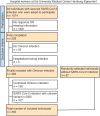Absence of self-reported neuropsychiatric and somatic symptoms after Omicron variant SARS-CoV-2 breakthrough infections
- PMID: 37038497
- PMCID: PMC10082557
- DOI: 10.1093/braincomms/fcad092
Absence of self-reported neuropsychiatric and somatic symptoms after Omicron variant SARS-CoV-2 breakthrough infections
Abstract
Persistent somatic and neuropsychiatric symptoms have been frequently described in patients after infection with severe acute respiratory syndrome coronavirus 2 even after a benign clinical course of the acute infection during the early phases of the coronavirus severe acute respiratory syndrome coronavirus 2 pandemic and are part of Long COVID. The Omicron variant emerged in November 2021 and has rapidly become predominant due to its high infectivity and suboptimal vaccine cross-protection. The frequency of neuropsychiatric post-acute sequelae after infection with the severe acute respiratory syndrome coronavirus 2 Omicron and adequate vaccination status is not known. Here, we aimed to characterize post-acute symptoms in individuals with asymptomatic or mildly symptomatic breakthrough infection with severe acute respiratory syndrome coronavirus 2. These individuals had either proven infection with the Omicron variant (n = 157) or their infection occurred in 2022 where Omicron was the predominant variant of severe acute respiratory syndrome coronavirus 2 in Germany (n = 107). This monocentric cross-sectional study was conducted at the University Medical Center Hamburg-Eppendorf between 11 February 2022 and 11 April 2022. We employed questionnaires addressing self-reported somatic symptom burden (Somatic Symptom Scale 8) and neuropsychiatric symptoms including mood (Patient Health Questionnaire 2), anxiety (Generalized Anxiety Disorder 7), attention (Mindful Attention Awareness Scale) and fatigue (Fatigue Assessment Scale) in a cohort of hospital workers. Scores were compared between 175 individuals less than 4 weeks after positive testing for severe acute respiratory syndrome coronavirus 2, 88 individuals more than 4 weeks after positive testing and 87 severe acute respiratory syndrome coronavirus 2 uninfected controls. The majority (n = 313; 89.5%) of included individuals were vaccinated at least three times. After recovery from infection, no significant differences in scores assessing neuropsychiatric and somatic symptoms were detected between the three groups (severe acute respiratory syndrome coronavirus 2 uninfected controls, individuals less and more than 4 weeks after positive testing) independent of age, sex, preconditions and vaccination status. In addition, self-reported symptom burden did not significantly correlate with the number of vaccinations against severe acute respiratory syndrome coronavirus 2, time from recovery or the number of infections. Notably, in all three groups, the mean scores for each item of our questionnaire lay below the pathological threshold. Our data show that persistent neuropsychiatric and somatic symptoms after recovery from severe acute respiratory syndrome coronavirus 2 infection in fully vaccinated hospital workers do not occur more frequently than that in uninfected individuals. This will guide healthcare professionals in the clinical management of patients after recovery from breakthrough infections with severe acute respiratory syndrome coronavirus 2.
Keywords: Long COVID; Omicron; SARS-CoV-2 breakthrough infection; neuropsychiatric deficits.
© The Author(s) 2023. Published by Oxford University Press on behalf of the Guarantors of Brain.
Conflict of interest statement
The authors declare no competing interests and no conflict of interest. MAF received honoraria for consultation and travel expenses from Biogen, Merck KGaA, Novartis and Roche unrelated to this work.
Figures



Similar articles
-
Risk and symptoms of COVID-19 in health professionals according to baseline immune status and booster vaccination during the Delta and Omicron waves in Switzerland-A multicentre cohort study.PLoS Med. 2022 Nov 7;19(11):e1004125. doi: 10.1371/journal.pmed.1004125. eCollection 2022 Nov. PLoS Med. 2022. PMID: 36342956 Free PMC article.
-
Post-Acute Sequelae After Severe Acute Respiratory Syndrome Coronavirus 2 Infection by Viral Variant and Vaccination Status: A Multicenter Cross-Sectional Study.Clin Infect Dis. 2023 Jul 26;77(2):194-202. doi: 10.1093/cid/ciad143. Clin Infect Dis. 2023. PMID: 36905145 Free PMC article.
-
Psychiatric and neuropsychiatric presentations associated with severe coronavirus infections: a systematic review and meta-analysis with comparison to the COVID-19 pandemic.Lancet Psychiatry. 2020 Jul;7(7):611-627. doi: 10.1016/S2215-0366(20)30203-0. Epub 2020 May 18. Lancet Psychiatry. 2020. PMID: 32437679 Free PMC article.
-
Postacute symptoms 4 months after SARS-CoV-2 infection during the Omicron period: a nationwide Danish questionnaire study.Am J Epidemiol. 2024 Aug 5;193(8):1106-1114. doi: 10.1093/aje/kwad225. Am J Epidemiol. 2024. PMID: 37981717 Free PMC article.
-
Infection-mediated immune response in SARS-CoV-2 breakthrough infection and implications for next-generation COVID-19 vaccine development.Vaccine. 2024 Feb 27;42(6):1401-1406. doi: 10.1016/j.vaccine.2024.01.088. Epub 2024 Feb 2. Vaccine. 2024. PMID: 38310015 Review.
Cited by
-
Differential Outcomes of Infection by Wild-Type SARS-CoV-2 and the B.1.617.2 and B.1.1.529 Variants of Concern in K18-hACE2 Transgenic Mice.Viruses. 2023 Dec 29;16(1):60. doi: 10.3390/v16010060. Viruses. 2023. PMID: 38257760 Free PMC article.
References
-
- Al-Aly Z, Xie Y, Bowe B. High-dimensional characterization of post-acute sequelae of COVID-19. Nature. 2021;594(7862):259–264. - PubMed
LinkOut - more resources
Full Text Sources
Miscellaneous
